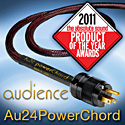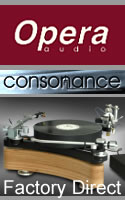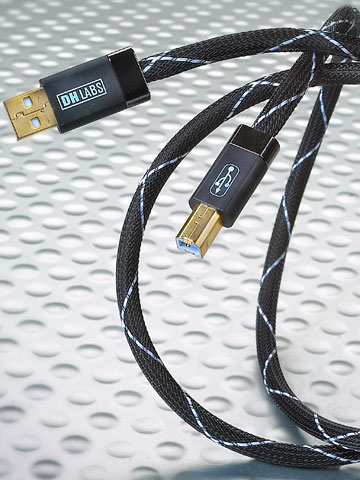|
|
You are reading the older HTML site
Positive Feedback ISSUE 59
dh labs Silver Sonic USB Cable as reviewed by Tom Gibbs
When I first got into the whole computer-based audio thing almost a year ago, I was pretty clueless with regards to most aspects of the entire experience; however, time has really helped bring me around, and now I easily feel that I'm getting some of my best digital playback ever, whether from CDs, FLACs or WAVs. I recently did a fairly extensive CD-to-FLAC-to-WAV series of comparisons—basically just for giggles—and, anyone who's into this obsession at just about any level of involvement is probably seriously interested in the controversy and hoopla surrounding it (just take a gander at the latest edition of The Absolute Sound, and the massive blog threads following it!) I guess I pretty much fall into the "bits-is-bits" camp, and although my methods are probably not the most scientific, I can hear no difference between FLACs and WAVs that I've created from identical sources. By all accounts, they appear to be bit-perfectly identical to each other, and if anyone is hearing a difference, I believe it's most likely due to either glitches during playback by the music player software or some preference setting or hardware related issue with the CPU employed as it unpacks the FLACs. I still feel that CDs sound the best—in my experiences, the differences are barely perceptible, but the unencoded CD (as played through the computer and DAC) has the slightest audible edge in terms of transparency and realism. But in terms of day-to-day listening, I'm more than happy—lets make that ecstatic—with the sound I'm getting from FLACs—as something of an analogue purist, I'm almost still in denial that it can be this good! And overall, while I feel that my relatively modest system offers a lot in terms of transparency, coherence and dynamics, I've really never been a hard-core "cable fanatic;" my audio cables are mostly good holdovers from a previous system incarnation with slightly higher audiophile leanings. The Audioquest Topaz interconnects that I use between the preamp and amp and elsewhere are over fifteen years old, yet provide a reliable and sonically uncolored connection. The Monster M1 speaker cables are closer to twenty years old, but were Monster's top-of-the-line cable at the time, and are still (in my view) pretty reliably neutral cables. When I moved my computer out of the listening room and into the adjacent room, I needed either a really long interconnect or USB cable; I initially chose to go the USB route, and this was my first experience with substandard digital cable reproduction. I ordered a five-meter Belkin USB Gold cable, and immediately noticed a really negative impression of music playback—much worse than any fan noise I was experiencing from having the computer in the same room as my system. There was an overall loss of transparency, a roll off of high frequencies and an overall dulling of the sound—I quickly went to the internet and found a number of reliable sources that pretty much nixed any USB cable length over about 3 meters for data (and especially music) transfer. At this point, I implemented Plan B by moving my DAC (the asychronous USB High Resolution Technologies Music Streamer II+) into the room with the computer, and ordering a five-meter length of Blue Jeans Cable LC-1. Which, by the way, has proven to be a very neutral and transparent choice. I replaced the USB cable with a one-meter Belkin USB Gold cable, and everything snapped back into focus. This experience, however, planted the first seeds of doubt in my mind that USB cables are all essentially equal; prior to the Belkin Gold cables, I'd been using just any available generic USB cable and enjoying what I considered to be pretty good results. Take into consideration that the first six or so months of my computer audio experiences was buoyed by a pretty steep learning curve; it probably took me two months to get my computer to stream a bit-perfect signal, among other customizations and music player considerations—I was pretty preoccupied. So when the offer from DH Labs came in October for the opportunity to evaluate their new USB cable I literally jumped at the chance! The Silver Sonic USB is available in lengths from .5 to 5 meters, and is constructed from high-purity OFHC (Oxygen-Free High-Conductivity) copper that is then coated with silver. The cables are then slowly and tightly wound, incorporating specialized techniques that are said to improve impedance characteristics and overall frequency response. The dielectric and insulation used is also designed to improve frequency response and waveform shape to provide better musical data transfer. When the package from DH Labs arrived, opening it was indeed a treat—the Silver Sonic is perhaps the most beautifully jewel-like cable of any sort I've ever had the pleasure to hold in my hands. Every aspect of the cable's construction is superb, with a stunningly elegant jacket and heavily-plated connectors. Now came the real challenge – how to properly evaluate this beauty! I decided to simply insert the new cable into the system for a period of time, then compare and contrast it with my existing Belkin Gold cable. That ended up being ten weeks, and after that period had ended, I chose to then make A/B comparisons utilizing a number of FLACs that I'm pretty infinitely familiar with and consider to be very musically revealing. Listening Results First up was the opening track from Rickie Lee Jones' remarkable cover album Pop Pop, "My One and Only Love," an astonishingly good acoustic performance (what on this album isn't great?). Via the Music Streamer II+ with the Silver Sonic USB, this music sounds as amazing on CD as it does on the 180 gram LP. After replacing the Silver Sonic with the Belkin cable (which I'd previously felt was a really good USB cable), Rickie Lee's trademark mumble became seriously recessed in the soundstage, Charlie Haden's excellent acoustic bass became tubby and less controlled—essentially, the soundstage had completely collapsed. Interchanging the Belkin with the Silver Sonic restored the music to its previous level of grandeur, and the experiment yielded the same result every time. And I switched these cables at least a dozen times over the course of the song, maintaining the same volume level—the cable swap was the only variable, yet there was a clear, unmistakable difference each and every time. Next up was Sarah McLachlan's "Angel" from her album Surfacing, which incorporates a really good acoustic piano intro with taut, controlled electric bass and Sarah's exceptionally liquid vocal. By removing the Silver Sonic from the system, that liquid midrange just evaporated; Sarah's otherwise superb vocal became totally recessed in the soundstage and all the air and any traces of the recorded acoustic almost vanished. The previously glorious acoustic piano lost all its sparkle, and the bass became much less well defined. Not to sound like a broken record, but frequent cable exchanges yielded the same result each time—restoring the Silver Sonic resulted in a much more liquid, extended treble response with a remarkably improved soundstage and tightly controlled bass—and additional proof that the initial result was no fluke. Another superb example of well-recorded acoustic jazz and female vocals is Diana Krall's major label debut, All For You (A Dedication To The Nat King Cole Trio). One of the most revealing tracks on the album is "You're Looking At Me," which features a duo with DK on vocals only and guitarist Russell Malone offering up maybe the most fluid and entertaining hollow-body solo of his career. Replace the Silver Sonic with the Belkin Gold, and Diana's vocal loses much of its' weight and presence, and Russell Malone's hollow-body becomes just that—hollow, and without much body. By this point, I'm totally shocked by the difference the Silver Sonic has been making in my system all this time—maybe it was the rush and crush of the ongoing Holiday season and all its trappings that obscured my perception of the Silver Sonic's amazing qualities. Regardless, I would never have believed that the difference could be so obviously apparent and so night-and-day between the two cables. Another classic recording I've been listening to quite a lot recently and marveling at how generally amazing it sounds is Miles Davis' Kind Of Blue, and a particularly good example is the track "Freddie The Freeloader." The FLAC is made from the 1997, 20-bit remaster, and as many countless times as I've heard this classic performance, I really hadn't listened to it via the Music Streamer II+ until recently, after I'd installed the Silver Sonic USB. Via this incredible combo, one can clearly hear all the classic spatial cues of the five players in Columbia's legendary 30th Street studio. Paul Chambers' bass is deep, resounding and well-defined, Miles' horn has nearly perfect tone and is perfectly anchored in the center, and Jimmy Cobb's cymbals have plenty of shimmer. Trade the Silver Sonic for the Belkin, and the soundstage becomes less diffuse, the cymbals sound less metallic—the overall presentation just became much less three-dimensional and engaging. And with every succeeding recording I played back, the results proved to be quite similar. In Conclusion I have a fair amount of experience with data cables of all sorts, but generally, none of them were carrying high-resolution audio signals, and I do realize that longer cable runs do tend to create signal and data flow problems for the associated equipment. So it really came as no surprise to me when I had problems with the 5-meter Belkin USB Cable, and most of the explanations that I came across throughout the web seemed pretty plausible. But I really didn't think that there'd be clear differences between similarly-sized data cables of reasonable construction. This review process has definitely proven to me that assumption is not correct. While it seems prudent to think that something as well constructed as the DH Labs Silver Sonic USB cable would perform admirably, it's been a truly remarkable trail of discovery to find that it indeed does make a huge difference. Whereas I previously would have thought $70 extravagant for a USB cable, I now feel that it's something of a tremendous bargain, especially in light of the incredible boost in performance it gave to my system. And it also reasons that longer lengths of cables built to the exacting standards of these cables from DH Labs would also perform at the higher level needed for music sources. Very highly recommended! Tom Gibbs
Silver Sonic USB Cable
(.5 meters)
DH Labs
|








